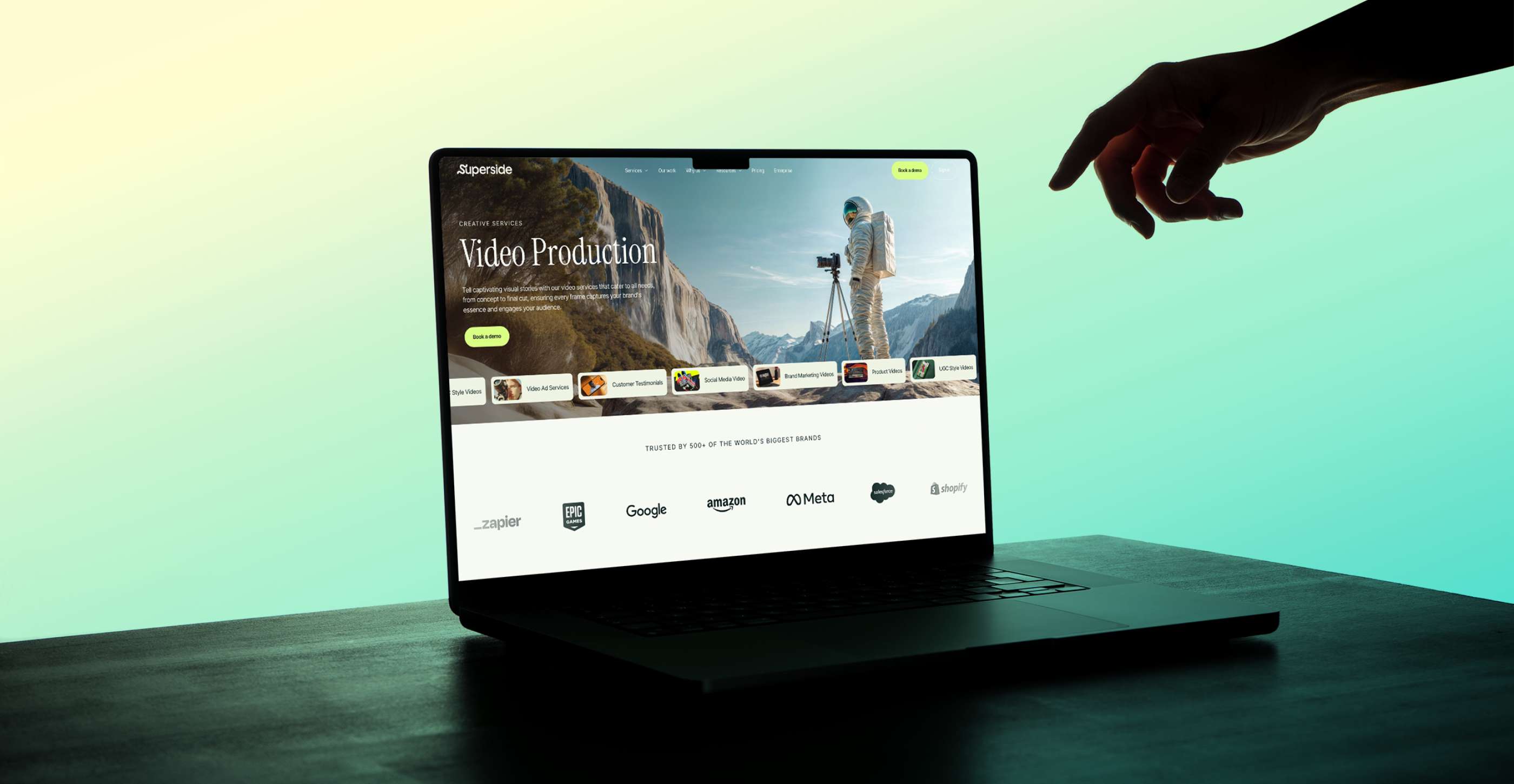6 Steps to a Full-Funnel Video Marketing Strategy


Most brands use video as a top-level awareness strategy, leaving video's many opportunities untouched. Video marketing experts say it's best applied as a full-funnel strategy, with video engaging personas at every stage of the cutsomer lifecycle. Here, Wistia's Senior Director of Brand Marketing shows you how to build a winning full-funnel video strategy with tools you've already got.
Video has far more utility than marketers give it credit for. It’s most lauded as a TOFU awareness vehicle, with most instances of video marketing populating a brand’s Instagram, LinkedIn and TikTok pages. If you were dishing out awards for conspicuous content, video would win most every time.
And yet, there are hundreds of possible uses for video in your marketing funnel, most of which you’ve probably never touched. Taylor Corrado, Senior Director of Brand Marketing at Wistia, says with a few minor tweaks, you could be using video to feed your whole marketing funnel. Not just the algorithm.
A full-funnel video marketing strategy is one of the smartest ways to stretch video to its full potential, and according to Corrado, you don’t even need a crap-tonne of new content to do it. Here, we’ll show you her method for turning your video marketing into an engine that attracts, engages, expands and advocates on your brand’s behalf.
Debunking the Video Marketing Myth(s)
Let's put some video marketing myths to rest first.
1. Video is no longer expensive or difficult.
If your marketing team has 1) someone with a video camera or phone, and 2) someone with an ounce of editing talent, you’ve got all you need to scale up your video efforts. Even the lowest tech is still high enough, and unless you’re marketing to A-list filmmakers, the barrier for entry into your audience’s eyeline is nonexistent.
2. You don’t need a boatload of new content and new ideas to scale video.
Most successful brands have a formula for the videos that support their marketing funnel, and a lot of it is driven by repurposing content from other internal sources.
3. You don’t need skilled actors for most of the content in your funnel.
While some TOFU video production can benefit from a little professionalism, a funnel filled with video content will be mostly educational, with just enough entertainment peppered in to keep an audience’s attention.
Video feeds the entire customer lifecycle
If you binned your spaghetti after eating only the sauce on top, some might say you were missing the point of spaghetti. Using video only as a TOFU awareness stream leaves a similar amount of substance on the plate.
The solution, Corrado says, is to build a stepped video marketing approach that doesn’t just stop when a prospect’s in the pipeline.
Video plays a role throughout the entire customer journey, not just at the very top where people traditionally spend the most time and money.

What’s a full-funnel video marketing strategy?
A full-funnel video marketing strategy uses video content to actively nurture your prospect through consideration, decision, adoption, expansion stages and beyond.
Where most brands’ video tactics are just beacons for prospects to look at the shiny object, a full-funnel video strategy beckons them to the object, sells it to them, shows them how their team can use it, prompts them to consider other objects, and gets them to tell their peers about the cool object that found them they found.
How to Build a Full-Funnel Video Marketing Strategy
With insights from Corrado’s Gather & Grow webinar at the center, we’ll walk you through six steps to a video strategy that elevates everything your marketing team—and your senior leadership—cares about.
Let’s see what video content you need to move your persona along at every stage of your customer’s journey, and what metrics you need to watch for. Let’s use Corrado’s advice as our anchor.
1. Awareness
When they don’t know anything about your brand, products or services, getting your persona’s attention is video’s most popular work.
If you have an internet connection, you’re well aware of the 80 million TOFU video campaigns born into the screaming void just two seconds ago. This is where you cast the widest net for your persona, reeling them in with whatever content the platform calls for.
The video content you really need is…
Something unselfishly educational. While “entertaining” is a default for many brands (often an appropriate one), Corrado emphasizes putting learning at the forefront: Use video to show your persona something they didn’t know. Something that’s useful whether or not they want your business. It shows them you’re an authority on the subject; and authority pays dividends in the long run.
Corrado points to her brand's own State of Video Report as a prime candidate for educational, awareness-driving video content.
We created a long-form piece of content that re-stated what was in an even longer industry report we already made. We had more than 125 hours watched on that video in a short time.

Example video: A shorter distillation of your best longform TOFU content
What to watch for: Hours watched
2. Consideration
When your persona is familiar with your brand, and is considering how your product or services could solve their problem(s), video needs to put them closer to those products and services.
The video content you really need is…
Something that solves their problem, but keeps them at the center of the story. Show them how they can use specific products or services in a video, framing each evidence point in your favor as a clear win for them. No need to get too fancy with it, either. Corrado says to focus on showing them how the product or service leaves them in a better spot than before—preferably on your own website.
You should be getting 20-30% engagement on a consideration video, like a demo. Think about where you can include that 5-minute length content on your website.

A video like the one below can work wonders for answering any lingering questions about what you do.
Example video: A demo video targeting and alleviating one of your persona’s specific pain points
What to watch for: Engagement Rate
3. Decision
When your persona’s deciding between you and your competitors, your video marketing funnel needs to make the decision easier.
The video content you really need is…
Something that makes your brand’s specific advantages clear; particularly in how it compares to competing brands. Make a video outlining what makes your offering different from your biggest competitor for a certain persona.
And here’s the rub: Corrado says it’s better to be honest. Video content that appears to offer an unbiased (or at least less-biased) take sits better with most viewers, so don’t be afraid to share some use cases in a competitor’s favor. It makes you appear even-handed, and makes sure the right people make it to the next stage.
When done right, Corrado says prospects will even stay on your site to engage with more content.
"If you’re honest and straightforward, people will watch it on your site instead of elsewhere," says Corrado.
Example video: A comparison video that weighs the pros and cons of several options for their solution
What to watch for: Engagement rate & heat mapping
4. Adoption
When your persona becomes your new customer, video can help make the product or service stick.
The video content you really need is…
Something that helps embed them in the product or service. While this one’s not strictly “marketing”, it’s a necessity for your new customer to progress through the marketing funnel—which means marketers have a role to play. Bring your audience on board with videos of people showing them how to do any technical work in a simple, friendly way. Product have the knowledge, but it’s marketing’s simplicity and, frankly, people skills that make these videos digestible.
You could even make FAQ videos. Your sales team gets the same questions all the time, so you could make short videos that literally answer one question each.

Example video: An integration video built around product’s knowledge, through the customer-centric lens of marketing, like this one
What to watch for: Play & engagement rate
5. Expansion
When a customer is either looking for, or open to getting more out of your relationship, don’t just tell them what’s on the table.
The video content you really need is…
Something that shows them what’s on the table. If there was a time to get a modicum more salesy, this would be it. Keeping them and their needs at the core, Corrado suggests using video to show your customer what other features and at other price points can do for them.
Take your upsell opportunities. If you have premium features, you can use video video to entice an upgrade.

Corrado's own brand found value in videos promoting new features, especially to their existing users.
Example video: A video showcasing new/upgrade features in action
What to watch for: Play & engagement rate
6. Advocacy
When a customer’s satisfied—and how could they not be, with all this intuitive video content—they can become a voice for your brand in their own network. Let video help them stick the landing.
The video content you really need is…
Something that showcases their win. With their victory over [insert problem] in hand, any willing or incentivized customer is a story waiting to be told. Corrado advises turning your customer’s win into a short, compelling video that clearly outlines the struggle, solution and result. As before, remember to make them the star of the show.
Make them a voice for you in their network. You can turn their story into thought leadership content that teaches their peers something new.

Example video: A snippet-sized video case study/testimonial, with the customer’s story (not your company) at the heart
What to watch for: Hours watched; word of mouth
Expert Tips for Your Video Marketing Funnel
Corrado shared a treasure trove of insight in her Gather & Grow session, the least of which we used to inform this piece. She had some lesser-known tidbits of general video wisdom to offer, which will help you navigate the increasingly crowded waters of video marketing.
1. Be educational in your videos, not salesy. Consumers want to learn from you, and video is one of the best mediums for it.
"Teach them something they didn’t know," Corrado says. "Educational video content accounted for almost 50% of all videos we uploaded in 2023. Consumers want to learn from you."
2. Don’t worry about being polished all the time. There’s a place for high-sheen videos, but it’s the information conveyed that’s most moving to your audience.
"Pre-pandemic, we were all obsessed with having this sheen of professionalism," notes Corrado. "But now, it’s acceptable to look accessible."
3. Get your people comfortable being on camera. Human faces perform better than any product, and there’s an authenticity to in-house talent that many viewers appreciate.
You can get people more comfortable on camera by starting out small. Build up peoples’ confidence to be on camera slowly; even if it’s just a video of them waving.

4. Get creative in your low-risk channels. Sometimes, thinking about how to present something boring (i.e. a survey) into something fun (i.e. a cute video dance asking the customer to complete a survey) can move people.
"Show off your brand’s voice," Corrado suggests. "If you're lighthearted, you can turn a pricing plan launch—something boring—into a video. We filmed ourselves having a small parade celebrating the launch."
4. Talk to your customer regularly, and make them the hero of your videos. Having consistent research, surveys and forums is especially important for video content.
"You need regular conversations with these people, preferably personally," Corrado says. "Having consistent research, surveys and forums also helps."
5. Use AI to cut the workload. You can use ChatGPT to come up with the concept and a script, use voice-clone tools to re-record missed audio, or use automated video editing tools to make quick adjustments on the fly. AI is one of the biggest video marketing trends for a reason.
"I remember having to really sell video to stakeholders," Corrado remembers, isolating the perceived investment as an issue for leadership. "But in the past few years, with the explosion of AI and general video tools, it’s easier than ever."
6. To scale, repurpose the content you already have. Think about the 30 second clips you can take from a webinar, or the snippets you can take from a blog post.
Repurposing long-form content is worth it. Think about the 30-second clips you can take from a webinar like this one. Scale with what you already have.

Take Full Advantage of Your Video Pipeline
Video can do so much more than we give it credit for. Like a bowl of de-sauced spaghetti, it yearns to fulfill its full potential.
Many hands make light work, though—especially when the hands are honed in the art of branded video production. If you’re curious to know what a dedicated, always-on team of video creative pros could do for your marketing funnel at any stage, we’re always happy to talk.
“I challenge everyone to take any piece of content, and think about how you could turn it into a video,” Corrado says. “If you’ve got someone dedicated to thinking about video, it’s way easier to maximize that output.”
David is a Senior Content Marketer at Superside. A former journalist with bylines too numerous to enumerate, he brings his love of storytelling and semantics to the marketing world. Recognizing the sizable gaps in the creative-as-a-service (CaaS) sector, he jumped at the chance to fill the creative void for ambitious brands. In his off hours, he enjoys loud music, making vegan meals and being made fun of for making vegan meals. He’ll gladly talk to you about any of the above on LinkedIn.
You may also like these

15 must-see brand video examples for inspiration (2025)
Video truly has killed the radio star—and pretty much every star there ever was in the world of digital marketing.Businesses that fail to get in on the brand video action are missing an enormous opportunity to tell their brand's story, showcase their products and services creatively, build brand awareness, boost engagement, create an emotional connection with their audience and set themselves apart from the competition.Compelling brand videos can also drive higher conversion rates, ultimately contributing to business growth and success.If you’re in need of a dose of brand video inspiration, you’re in luck. Read on to learn about the power of brand videos, what it takes to make a successful brand video, plus lessons in getting the creative process right with our round-up of some of the best brand video examples out there.The power of brand videos in marketing
7 short-form video trends to maximize impact in 2025
Short-form video’s popularity is skyrocketing. Thanks to the likes of TikTok, Instagram Reels and YouTube Shorts (and our diminishing attention spans), the way people consume media has shifted dramatically. These days, people crave bite-sized, engaging snippets of content that entertain, educate and connect us.Short-form video ticks all these boxes. This is why brands are tapping into the format for its high shareability and potential for rapid audience growth like never before.Ready to ramp up your short-form video content? Our end-to-end video services help enterprise brands with everything from strategy and concept to production and iteration—all while leveraging the benefits of AI whenever it’s a fit.Where should you start? Right here. Explore the seven trends in short-form videos shaping 2025 with Superside's Video Production Director, Ashlee Fitzgerald.The rise of short-form video
Your guide to mastering video at scale for brand growth
Over the last few years, video content has emerged as a critical driver of brand growth. Now more than ever, consumers engage with brands through dynamic, visual storytelling. As a result, scaling video production has become an important goal for enterprises set on hitting a high ROI on their marketing spend.But producing high-quality, consistent video content at scale presents significant challenges, from managing resources to the complexities of creating a cohesive brand narrative across numerous formats, locations and platforms.In this guide, we’ll share the proof you need to get buy-in for scaling video production, provide actionable strategies and tools for growth through video, and go over how the right partnerships (like teaming up with Superside) can help you overcome common challenges when creating video content at scale.Why scaling video production is key to brand growthVideo consumption is growing rapidly worldwide, and it’s easy to see why: Video is dynamic. Instead of looking at a static page, you’re engaging your audience with visuals, audio and motion. Whether your goal is to educate or entertain, video can help get your brand message across in innovative ways.









